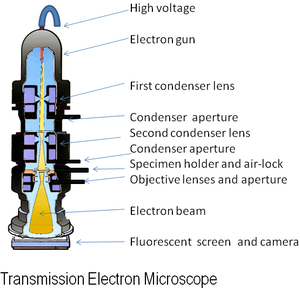Electron microscopy (3LF)
- Previous chapter: 6.1.1 Optical microscopy
Unlike the optical microscopy we use a beam of electrons. An electron microscope (EM) has greater resolving power than a visible light microscope because electrons have wavelengths about 100,000 times shorter than visible light photons. On the other hand, classical optical lenses and mirrors cannot be used and also the whole apparatus has to be located inside a high vacuum chamber. The source of electrons is an electron gun. The electrons are produced by simple thermoemission from LaB6 crystal or tungsten filament. These electrons are next sped up using high voltage (kilovolts) and focused by magnetic coils. There are several types of electron microscopy, however there are two main types: transmission microscopy, where electrons pass through a specimen and scanning electron microscopy where the electrons are reflected from a specimen and then detected.
Figure 6 - transmission electron microscope.
Figure 7 - Ant in scanning electron microscope.
Links[edit | edit source]
Next chapter: 6.2 ULTRASONOGRAPHY (SONO)
Back to Contents


